
There is a particular clarity that arrives when the shore shrinks behind and the horizon opens in every direction. The water does not rush to be anything other than what it is, and being on it encourages a similar ease. Whether standing on a paddleboard at dawn, rowing in an afternoon breeze, or riding a sailboat under a wide sky, time on the water offers a chance to slow down, listen, and rediscover the quieter parts of life.
Human beings have always gravitated toward water — rivers, lakes, and oceans. The sound of waves and the sight of reflective surfaces trigger a deep, almost instinctual response. Scientists point to biophilia, the innate affinity for nature, as part of the reason; others note that water's rhythmic qualities can ease the nervous system and lower stress. Regardless of the explanation, there is a tangible difference in mood and perspective after even a short outing.
Beyond the physiology, water offers a landscape that is at once simple and complex. It can be calm and mirror-like, or wild and demanding. That range creates opportunities: easy days for contemplation and skill-building, and challenging days for testing resilience and focus. The variety keeps experiences fresh and provides multiple pathways to self-discovery.
Moreover, water connects us to a timeless cycle of renewal and change. Tides rise and fall, streams carve new paths, and rain refreshes the earth — all reminders of life's constant ebb and flow. This connection can foster a sense of humility and perspective, encouraging us to embrace impermanence and adapt to shifting circumstances. The enduring presence of water in our environments serves as a grounding force, reminding us of the deep interconnection between all living things.
Engaging with water also stimulates the senses in unique ways. The cool touch of a stream, the salty spray of the ocean, and the subtle smells of aquatic plants create multi-sensory experiences that heighten awareness and mindfulness. These moments can act as a form of moving meditation, where the mind settles into the present and distractions fade away. Through such interaction, water offers more than recreation — it becomes a portal to greater inner calm and insight.
Matching the right watercraft to desired experiences is important. Each option brings its own pace, posture, and set of skills. Stand-up paddleboards slow the world down and encourage balance and breath awareness. Kayaks put the body close to the waterline and allow for immersive exploration of coves and channels. Canoes are great for sharing space and conversation, while sailboats translate the physics of wind into an elemental form of travel. Small motorboats offer access to distance quickly, and rowboats emphasize rhythm and teamwork.
Consider the goals for a trip before choosing equipment. For introspective mornings, a single kayak or SUP might be ideal. For time with friends and conversation, a canoe or larger sailboat creates shared space. For solitude and distance, a light sailing dinghy or a quiet electric boat can move farther while keeping the tone calm. Renting equipment for a day or taking a beginner lesson provides a low-commitment way to test preferences before investing in personal gear.
Time on the water invites a mindset that emphasizes attention, acceptance, and small successes. The act of balancing, trimming a sail, or finding the right paddling cadence shifts focus from internal narratives to present sensations. This redirection provides mental rest: worries do not disappear, but they tend to lose their immediacy when attention is anchored in breath, posture, and the sound of movement through water.
There is also a lesson in acceptance. Conditions change—wind increases, currents alter course, shadows shift—and adaptability becomes more valuable than control. Practicing flexibility on the water translates to daily life in subtle ways. The confidence that comes from handling an unexpected gust or a change in tide is not about mastering nature, but learning to respond with steadiness.
Silence on the water often feels different from silence on land. The absence of traffic noise and the presence of natural sounds create a deeper sense of listening. Observing bird behavior, the ripple of fish, or the sigh of reeds can become a form of active meditation. These moments invite reflection without pressure, allowing thoughts to rearrange into clearer priorities.
Flow states are more accessible when movement and environment cooperate. Paddling strokes and wind adjustments offer repetitive, meaningful actions that can absorb attention. These tasks provide just enough challenge to be engaging without being overwhelming, producing a balance that many describe as restorative and clarifying.
Comfortable, safe experiences start with preparation. A personal flotation device (PFD) appropriate for the type of boating should always be worn. Understanding local conditions—wind patterns, tides, currents, and weather forecasts—reduces surprises. Carrying basic safety gear such as a whistle, a waterproof phone case, a small first-aid kit, and a signaling device is wise, even on short trips.

Clothing choices matter: layered, moisture-wicking fabrics prevent chills, and a hat with sun protection helps reduce glare and sunburn. Footwear that provides grip and dries quickly increases confidence when launching or stepping aboard. Hydration and snacks are often overlooked but important; dehydration can sneak up during calm sunny days, and a small pack with water and healthy food supports longer outings.
Local regulations and etiquette vary. Knowing right-of-way rules, no-wake zones, and restricted areas protects both people and wildlife. Be mindful of nesting birds and sensitive shorelines; keeping distance preserves habitats and keeps encounters pleasant. When unfamiliar with a body of water, it helps to ask locals or check guides for hazards like submerged rocks, strong currents, or seasonal changes in access.
Learning a few foundational skills pays dividends quickly. Practice re-entry techniques for kayaks and paddleboards, learn to read basic wind and tide signs, and drill simple rescue methods when with a partner. Taking a short course or a guided trip accelerates competence and comfort. Confidence grows with experience, and that growth enlarges the scope of what can be enjoyed safely.
Water outings can be structured for relaxation, skill-building, social connection, or introspection. For mental clarity, try short, repeated sessions instead of rare, long trips; regular exposure compounds the calming effects. For fitness, interval paddling or longer distance rows develop strength and cardiovascular health while minimizing impact on joints. For creativity, take a sketchbook or a voice recorder; the changing scenery often unlocks fresh ideas or lyric turns of phrase.

Group outings also offer rich opportunities. Shared tasks—rigging a sail, making a relay of paddles, navigating a channel—create bonding experiences that feel more alive than many land-based activities. Silence together can be just as meaningful; a shared dawn paddle where everyone moves in quiet collects a communal calm that continues afterward.
Not all waterways are the same, and choosing the right destination shapes the nature of discovery. Quiet inland lakes and gentle rivers are ideal for slow exploration and wildlife watching. Coastal estuaries and sheltered bays provide varied scenery and the chance to witness migration, tidal changes, and rich ecosystems. Open water and larger lakes offer challenges that reward skill and endurance. Urban waterways bring a different kind of magic: the juxtaposition of cityscapes and reflective surfaces creates a modern kind of serenity.

Selecting a destination also means respecting its demands. Remote spots require better planning for supplies and emergency communication. Popular areas may mean more traffic on busy weekends, which can reduce the sense of solitude but increase opportunities for social connection. A balance between solitude and convenience helps tailor trips to current needs.
Seasons change the experience dramatically. Spring and fall often bring migrating wildlife and cooler temperatures, encouraging crisp, focused outings. Summer offers long days and warmer water but requires careful sun and hydration management. Winter paddling or sailing, when approached with proper gear and experience, can feel like a rare invitation into a quieter world and reveal landscapes that are otherwise inaccessible.
Time on the water often returns something subtle but lasting: a recalibration of pace, a refreshed set of priorities, and a small book of moments that keep resurfacing during busy weeks. The practice of checking in with breath, attending to small details, and responding to changing conditions carries forward into daily life. The water does not fix everything, but it offers a clear mirror in which to assess what matters and to gather strength for the parts that follow.
For those seeking a way to reset without drastic change, regular time on the water can become a dependable ritual. It requires minimal commitments beyond a willingness to show up and a readiness to learn. Over time, confidence grows, curiosity deepens, and the act of finding oneself becomes less about a single epiphany and more about a steadying presence that returns again and again.
For those drawn by the call of water, the next step is simple: find a local rental shop or an introductory class and plan a short outing with realistic expectations. Start with calm conditions and a partner, wear a PFD, and focus on presence rather than distance. Each session teaches something—about balance, weather, or how attention softens—and these small lessons add up quickly.
Being on the water is a practice as much as it is a pleasure. It has a gentle way of rearranging priorities and returning a clearer sense of self. Whether the aim is solitude, exercise, creativity, or companionship, the water offers a space where the pace of life can be measured in strokes and breaths, and where the horizon becomes a quiet invitation to keep exploring.
Embrace the clarity and calm found on the water every day at Tennessee National. Nestled in Tennessee’s stunning landscape, our premier gated community offers luxury living with direct access to a private marina, scenic nature trails, and a Greg Norman Signature Golf Course. Whether you seek a move-in ready home or a custom build, Tennessee National is your gateway to resort-style living designed around tranquility and connection. Schedule a private tour today and start making memories where the water meets home life.